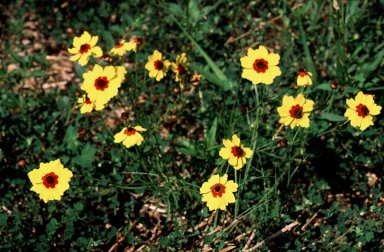Detail View: Kansas Wildflowers: Coreopsis tinctoria Nutt.

|
Catalog Number:
|
3790
|
|
Record ID:
|
KBS_LARC.3790_1200.Core_tin2.tif
|
|
Global Unique Identifier:
|
URN:science:KBS:wildflower:3790
|
|
Institution Code:
|
KBS
|
|
Date Last Modified:
|
12/16/2004
|
|
Basis Of Record:
|
observation
|
|
Scientific Name:
|
Coreopsis tinctoria Nutt.
|
|
Family:
|
Asteraceae
|
|
Genus:
|
Coreopsis
|
|
Species:
|
tinctoria
|
|
Scientific Name Author:
|
Nutt.
|
|
State or Province:
|
Kansas
|
|
County:
|
Crawford
|
|
Locality:
|
McCune, 1 mi S, 1 mi W along US 160.
|
|
Physiographic Province:
|
Cherokee Lowlands
|
|
Associated Plant Community:
|
Disturbed
|
|
Collector:
|
Craig C. Freeman
|
|
Date Collected:
|
8/21/1990
|
|
Rights:
|
Craig C. Freeman
|
|
Source:
|
Kansas Wildflowers Database, Kansas Biological Survey, University of Kansas
|
|
Genus Name Meaning:
|
From Greek koris (" bug") and opsis (" resembling"), referring to bug-like seeds
|
|
Species Name Meaning:
|
used for dyeing because flowers were used to make yellow or brown dye
|
|
Common Names:
|
Plains coreopsis
|
|
Description:
|
Plant life form: Annual
|
|
Description:
|
Height: 6-12 dm
|
|
Description:
|
Species description: Ray florets are yellow with a prominent reddish spot at the base; disk florets are reddish. Flowers bloom from June to October.
|
|
Description:
|
Species description: Erect annual or occasionally short-lived perennial herb. Stems arise singly and are heavily branched. Leaves are opposite and pinnately or twice-pinnately compound.
|
|
Description:
|
"Habitat: Damp, disturbed sites including roadsides and ditches."
|
|
Description:
|
Range in Kansas: Throughout the state.
|
|
Description:
|
Edible uses: Flowers and fresh or dried plant can be boiled to make tea
|
|
Description:
|
Medicinal Uses: Tea made from roots used to treat internal bleeding and diarrhea and to induce vomiting.
|
|
Description:
|
Other uses: Plants placed in mattresses by early pioneers as flea and bedbut repellent. Flowers can be used to make yellow or brown dye.
|
|
Description:
|
Notes: Bees are attracted to flowers.
|
|
Description:
|
"Cultivation: Drought-tolerant. Grows best in well-drained, average or sandy soil in full sun to partial shade."
|
|
Description:
|
Propagation: Seed--plant in late fall or early spring
|
|
Color:
|
Yellow
|